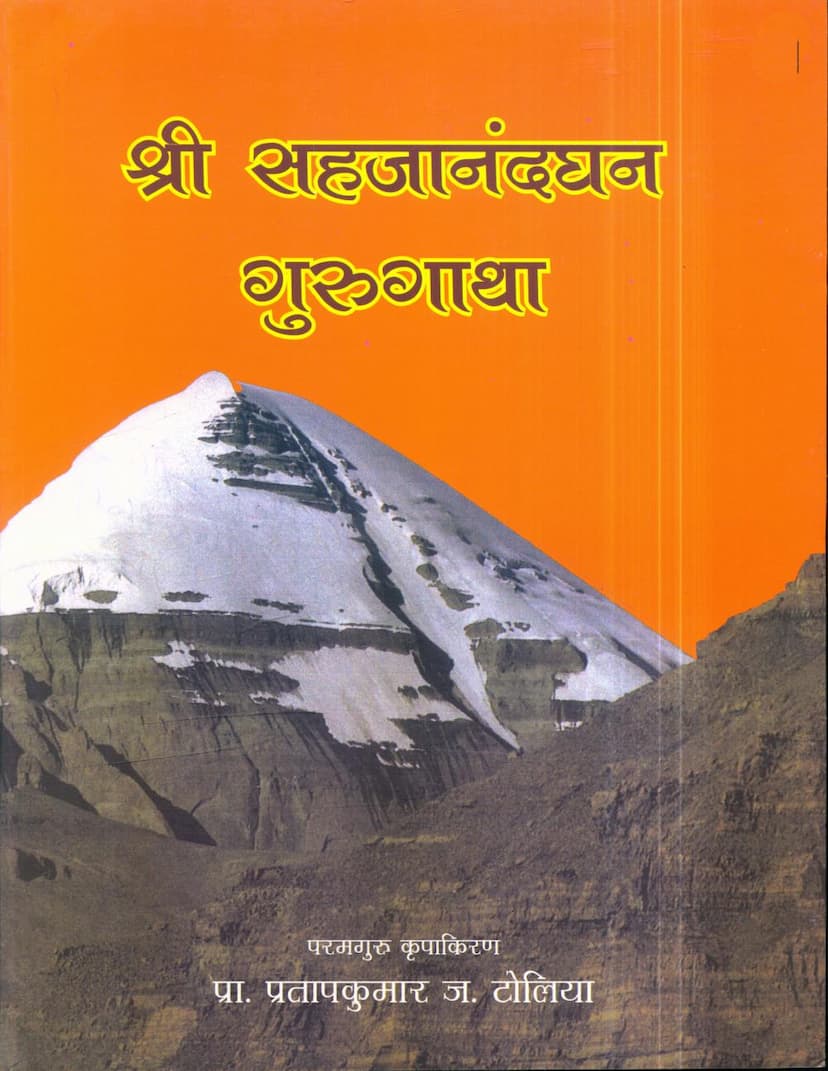Sahajanandghan Guru Gatha
Added to library: September 2, 2025

Summary
This is a comprehensive summary of the Jain text "Sahajanandghan Guru Gatha" by Pratap J Tolia, based on the provided pages. The text is essentially a biography of the revered Jain spiritual leader, Yogindra Yugapradhan Shri Sahajanandghanji (also known as Bhadramuni).
Title: Shri Sahajanandghan Gurugatha Author: Prof. Pratapkumar J. Toliya Publisher: Jina Bharati, Vardhaman Bharati International Foundation
Core Theme and Purpose:
The book is dedicated to illuminating the life, teachings, and spiritual significance of Yogindra Yugapradhan Shri Sahajanandghanji Maharaj. It aims to bring the profound spiritual legacy of Shri Sahajanandghanji, and by extension, the teachings of Bhagwan Mahavir and Param Krupalu Shrimad Rajchandraji, to a wider audience. A key objective is to disseminate Shrimad Rajchandraji's spiritual literature beyond its linguistic and regional boundaries, making it accessible to people of various languages and backgrounds.
Key Aspects and Content:
-
The Central Figure - Shri Sahajanandghanji:
- He is presented as a divine spiritual guide, an "Adhyatma Yogi," and a "Yugapradhan" (leader of an era).
- His life is described as a journey of profound spiritual realization, characterized by detachment, intense sadhana (spiritual practice), and a deep connection to the teachings of Shrimad Rajchandraji.
- He is portrayed as a person of immense humility and selflessness, actively encouraging his followers to focus on Shrimad Rajchandraji's teachings rather than his own personality.
- His spiritual journey involved significant periods of solitary practice in caves and forests, emphasizing a direct experience of the soul (Atman).
-
Connection to Shrimad Rajchandraji:
- The text repeatedly highlights the deep spiritual connection and discipleship Shri Sahajanandghanji had with Shrimad Rajchandraji.
- Shri Sahajanandghanji's mission is described as furthering the dissemination of Shrimad Rajchandraji's spiritual literature and the "Mool Marg" (original path) taught by Bhagwan Mahavir.
- The publication of translations of Shrimad Rajchandraji's works, like "Atma Siddhi," is seen as a fulfillment of Shri Sahajanandghanji's aspirations.
-
The Setting - Karnataka and Hampi:
- The narrative emphasizes the spiritual significance of Karnataka, particularly Hampi, as a place of profound spiritual activity.
- Hampi, with its ancient Jain heritage (Hemkuta, Chakrakuta, Ratnakuta), is presented as a place where Shri Sahajanandghanji established the Shrimad Rajchandra Ashram.
- The historical and geographical context of Hampi, including its Jain past and the ruins of the Vijayanagar Empire, is detailed to highlight the spiritual importance of the chosen location.
-
The "Saptabhashi Atma Siddhi" Project:
- A significant part of the text discusses the motivation behind translating and publishing Shrimad Rajchandraji's "Atma Siddhi" in multiple languages.
- This project is a direct result of Shri Sahajanandghanji's desire to spread Shrimad Rajchandraji's message globally.
- The author, Prof. Pratap J Tolia, was inspired by Shri Sahajanandghanji to undertake this work, and the book itself is a testament to that inspiration.
-
The Author's Perspective and Journey:
- Prof. Pratap J Tolia recounts his first meeting with Shri Sahajanandghanji, describing it as a significant spiritual encounter.
- He details his personal journey of devotion and dedication, culminating in leaving his academic career to dedicate himself to the mission inspired by Shri Sahajanandghanji and supported by Shrimad Rajchandraji's teachings.
- The author expresses deep respect and gratitude towards Shri Sahajanandghanji and other spiritual figures who guided him.
-
Spiritual Principles and Practices:
- The text touches upon various aspects of Jain spirituality, including the importance of Atma Vichar (self-inquiry), the pursuit of Atma Siddhi (self-realization), the significance of the Namokar Mantra, and the integration of Bhakti (devotion), Gyan (knowledge), and Yoga (spiritual discipline).
- It highlights the essence of Jain Yoga as described by Shri Hemchandracharya and others, emphasizing the path towards liberation through self-realization and detachment.
- The teachings emphasize purity of thought, word, and deed, and the importance of following a Guru (Sadhguru) for spiritual progress.
-
Key Figures and Their Roles:
- Shri Sahajanandghanji: The central figure, a Yugapradhan, inspired by Shrimad Rajchandraji.
- Shrimad Rajchandraji: Revered as the "Param Guru" and a guiding light.
- Prof. Pratap J Tolia: The author and devotee, who undertook the monumental task of documenting Shri Sahajanandghanji's life and promoting Shrimad Rajchandraji's literature.
- Mataji Dhanadevi: A significant spiritual figure associated with the Hampi Ashram, described as a "Jagatmata" (Universal Mother) who played a crucial role in the spiritual lineage and the dissemination of teachings.
- Vimalatai Thakar: A key supporter and collaborator, instrumental in the "Saptabhashi Atma Siddhi" project.
- Shri Chandubhai Tolia: Brother of the author and Ashram administrator, who played a vital role in the Hampi Ashram's establishment and activities.
Structure and Style:
The text is structured into several chapters and appendices, delving into the historical context of Karnataka, the spiritual background of Shri Sahajanandghanji, his personal journey, the establishment of the Hampi Ashram, and significant spiritual insights derived from his teachings and letters. The writing style is devotional and reverent, filled with scriptural references and personal anecdotes.
Overall Message:
"Sahajanandghan Guru Gatha" serves as an ode to a great Jain spiritual master and a powerful testament to the enduring impact of Jain philosophy and the lineage of enlightened beings like Shrimad Rajchandraji and Shri Sahajanandghanji. It inspires readers to seek self-realization, follow the path of righteousness, and spread the message of peace, non-violence, and spiritual wisdom. The book underscores the importance of recognizing and propagating the timeless teachings of these spiritual giants for the welfare of humanity.